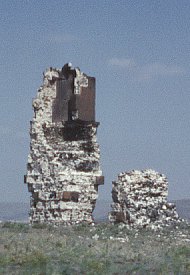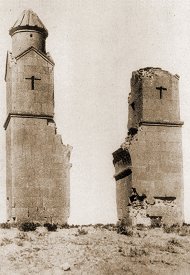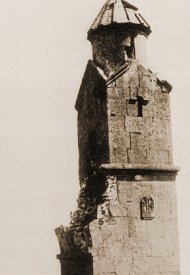Below and to the north of the main complex, three churches stand on a rise in the ground that is encircled by a dried-up meander of the river. These churches are older that anything that survives within the main complex, and the original site of the monastery may have been here. Old views show them surrounded by khatchkars and other funereal monuments - all of which are now gone. The churches are (from west to east) known as Saint Minas (Surb Minas), Saint George (Surb Gevorg), and the chapel of King Ashot.
The Saint Minas and
Saint George Churches
These two churches are almost identical in design, and have a rather mass-produced look to them. Architecturally, they are both of the rectangular "domed-hall" type of church.
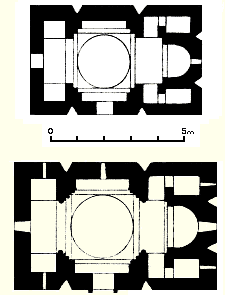
The date of construction for St. Minas is not known. However, it had a donative inscription dated 986, recording the gift of an orchard to the monastery. Most of the drum and dome has fallen, probably as a result of an earthquake.
The church of St. George is slightly larger that that of St. Minas. Again, most of the drum and dome has fallen. An inscription records that it was built by King Gagik I of Ani (who ruled from 989-1120) with the tone of the words suggesting that the building work was completed after his death.. The interior was painted (probably at a later date) and there are still faint traces of frescoes within the apse. The entrance is in the south facade, and old photographs suggest a walled enclosure in front of the entrance.
King Ashot's Chapel and Tomb
A little to the east of the Saint George church are the remains of a small, single nave, barrel vaulted chapel with a semicircular apse. Only parts of its north and east walls remain standing.
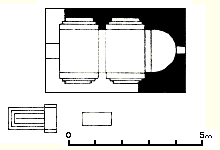
Close to the south-west corner of this chapel there was once a large monument that bore the inscription "Ashot T'agawor" (Ashot the King) and the date 977. This is thought to have been the tomb of King Ashot the third (who ruled from 953 to 977). The raised block of stone at its eastern end was probably the base for a large khatchkar. To the east of this tomb there was another tomb, traditionally thought to be the tomb of Ashot's wife, Xosrovannush. The engraving below, from the 1880s, shows the tomb. Photographs of it also exist.
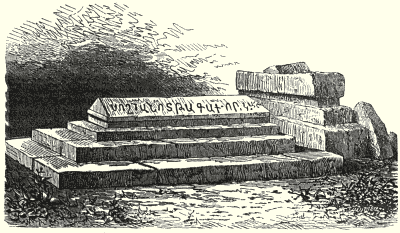
King Ashot's tomb survived at least until 1920 - now, not a single stone remains of it. Given the symbolic and historic importance of this tomb, and the totality of its removal, it was probably a politically inspired destruction undertaken by the Turkish authorities.
The Triumphal Arch
Beside the track from Ani, and overlooking the monastery, are the fragmentary remains of an intriguing and unique structure known as the "triumphal arch". It consisted of twin towers in the form of massive rectangular piers, joined by an archway. The drawing below is a reconstruction.

The towers extended above the archway level - and at the summit of each was a little domed chapel. A door at the base of each tower gave access (via a stairway?) to the chapels, and to a walkway above the archway. An inscription on one of the towers is dated 1102 - so the arch was probably built during the Bagratid era. This structure was largely intact before 1920 - very little of it now survives.
The Taylar Church
This is an isolated church located 2km to the north of Horomos monastery. Its original name is unknown, and it is now known as the Taylar church (named after a nearby village). It probably dates from the 10th century.
...back to the second page on Horomos.
